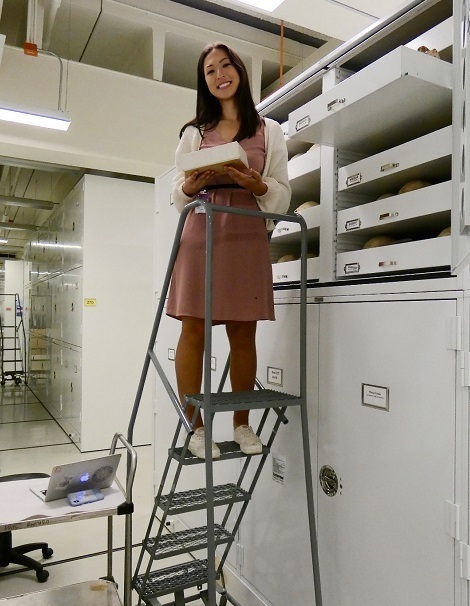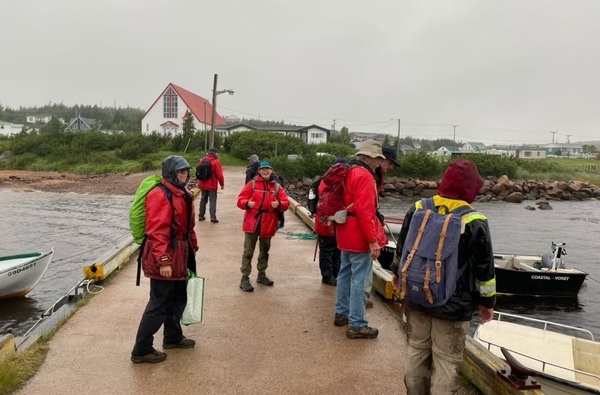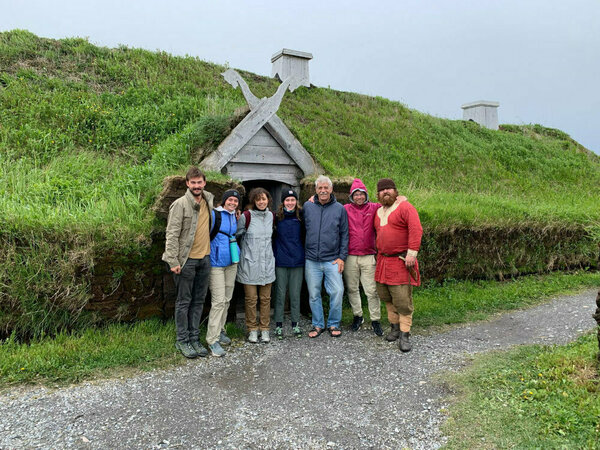Smithsonian Internship

Notre Dame anthropology majors and minors have an exclusive opportunity to participate in research and training internships with the National Museum of Natural History (NMNH) in Washington DC. The Museum staff guarantees that at least one of our students will be selected for their summer internships.
This program, funded by Notre Dame's Department of Anthropology, represents the first collaboration of its kind between the Smithsonian and a university.
The Smithsonian selected Notre Dame for this partnership because of the department's four-fields approach, distinguished faculty, and strong commitment to undergraduate research.
Intern Duties
The Anthropology Division of the National Museum of Natural History will mentor students for an educational and career-building internship opportunity. Students will be paired with the most appropriate available sponsor at NMNH. Potential projects may fall in the categories of field, laboratory, or archival research in either archaeology or physical anthropology; collections development (researching a particular aspect of a collection to improve documentation or accessibility); or museum practice (likely research related to exhibit development). We will post information about the specific opportunities available for the upcoming summer as soon as it becomes available. To meet previous interns and read about their experience with MNNH see the bottom of this web page.
Internships are 10 weeks, timed to the UND summer schedule. Students will be supported with a stipend to help defray costs associated with transportation, housing, and meals.
Applying
To apply for the University of Notre Dame Anthropology Smithsonian Internship, please submit:
- A letter of application describing:
- Why you would like to be an intern at the NMNH.
- Your qualifications.
- How this internship fits into your future plans to engage in anthropology. (Include a discussion of the types of research projects in which you would like to be involved.)
- An updated curriculum vitae (NOT a resume).
- Contact information for at least one letter of recommendation.
- Send your complete application to EJHaanstad@nd.edu or bring your application to:
- Smithsonian Internship
- University of Notre Dame Anthropology Department
- 296 Corbett Family Hall
- Notre Dame, IN 46556
The Internship Selection Committee is unable to consider incomplete applications and/or application packets submitted after the deadline.
Submission Deadline: April 5, 2024 by 4pm.
The following proposed projects may be available to the 2024 intern:
Intern Sponsor: William Fitzhugh, Curator, Arctic Archaeology
The Arctic Studies Center’s “St. Lawrence Gateways Project” has been studying the archaeology of the northeastern Gulf of St. Lawrence for the past 10 years, concentrating on a Basque whaling site dating ca. 1600-1700. Also present at this site is the southernmost Labrador Inuit (Eskimo) occupations known and marks an important development in European-Inuit relations, which before 1700 were largely hostile. The field project takes place from 20 July to 28 August and includes boat-based archaeological surveys and excavations. The 8-person team lives on a Smithsonian research vessel and conducts archaeological work along the Quebec Lower North shore from Cape Whittle (Harrington Harbor) to the Strait of Belle Isle. Activities will include excavations and field surveys. Participants need to be healthy, have previous outdoor experience, and be able to work effectively in semi-isolated conditions.
Previous Intern Stories
Alyssa Miulli, Summer 2023, Smithsonian Museum of Natural History in Washington D.C.

During the summer of 2023, I had the incredible opportunity to work under Dr. William Fitzhugh from the Smithsonian Institute to excavate a 16-17th century Basque whaling site on the island of Bonne Esperance. I experienced this journey along with students from the University of Colorado Boulder and the University of Montreal. The "American Quarter" of the team journeyed through New Brunswick, Newfoundland, Labrador, and Quebec to fully understand the history of the Lower North Shore. During this journey, we saw icebergs, whales, moose, and beautiful glacial fields. We spent a majority of the summer at St. Paul River, where the Whiteley Museum hosted our team. I learned so much about excavation techniques, Basque and Inuit cultures, as well as artifact cataloging and preservation. Along with conducting archaeology, Dr. Fitzhugh took our team to other heritage sites such as Red Bay, Port au Choix, and L'Anse aux Meadows so that we could understand the holistic history of the region. This internship not only taught me about the practices of archaeology, but also provided an opportunity to connect with the present culture of the Lower North Shore. The Whiteley Museum gave me the resources to create a film about this culture, which can be viewed here. I am incredibly grateful to the University of Notre Dame and Ms. Virginia Coss for providing this opportunity to me. It was truly an unforgettable experience, thank you!
Mia Ayer, Summer 2019, Smithsonian Museum of Natural History in Washington D.C.
During my internship experience at the Smithsonian, I had the opportunity to work with Dr. Sabrina Sholts, Dr. Andrea Eller, and Rita Austin in collecting data for a larger ongoing project called EMPHASIS (Environmental Mismatches in Primates and Humans: Anthropogenic Settings and Impacts Survey). This study largely focuses on how both humans and nonhuman primates are impacted by their environments, assessing differences in observed paleopathological markers across age, sex, and pathology categories. With the help of my wonderful supervisor Rita Austin and the collections manager Dave Hunt in the Museum Support Center, I was able to discern and recognize bony pathologies and gain a better general understanding of human anatomy in over 1200 individuals in the human Biological Anthropology collections, all of whom were from ~1200-1500 CE, pre-Spanish contact Peru. Using the collected data, I developed my own research questions to pursue and develop into a poster project, which I plan to continue researching as part of a thesis project. The project under the guidance of my mentors at the Smithsonian revolved around a bony pathology of the skull within the ear, called external auditory exostosis (EAE), which was relatively frequent in the Peruvian collections I surveyed. Specifically, I explored whether the pathological etiology aligned with previous studies asserting EAE is solely associated with water temperature, and analyzed my findings within a biocultural framework. Through this experience I was able to not only greatly round out my knowledge in biological anthropology, but open so many new doors and opportunities which pushed me to engage in the discipline in ways I had not considered before. The total immersion into such a driven and supportive team of people who are excited about anthropology really intensified my passion for the discipline- the relationships built during my time there will be lifelong.
Noémi Toroczkai, Summer 2019, St. Lawrence Gateways Project in Quebec
This summer I embarked on an incredible journey to the Arctic as an archaeological intern for the Smithsonian Arctic Studies Department. It was an experience of a lifetime, to say the least. I learned so much about the archaeological process, through the expertise of Dr. William Fitzhugh, an incredibly knowledgeable archaeologist who is known for his work in the Arctic. I lived on a 50-ft long boat named the Pitsiulak with two other interns from Dartmouth, our skipper Perry, two archaeologists with various specialties, and a crew of archaeological divers from the University of Montreal. While the divers went around looking for underwater sites and shipwrecks, the dig-team surveyed many areas along the northern coast of Quebec. We spent a lot of time excavating at two sites: Hart Chalet and Grand Isle. I learned many new skills such as how to use a trowel, how to map and record profiles, and how to map entire sites to scale on a piece of graphing paper. Through this internship I was able to explore an area of the world that is rarely frequented by anyone. I saw icebergs, whales, puffins, dolphins, historical Norse sites, and much, much more. I met and interacted with the local communities we visited and learned about what it is like to live in such environmentally unfavorable conditions year-round. I learned about Inuit history and Basque trading and whaling practices. This internship allowed me to form bonds with the rest of my team members that I know will last even after we all have parted ways. This was an experience of a lifetime, and I will always cherish the memories that come from it. I’m incredibly grateful for the support of Ms. Virginia Coss and her family for giving me the opportunity to have such a fruitful experience. Thank you so much!
